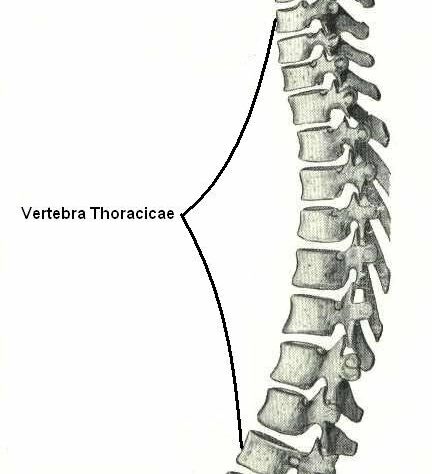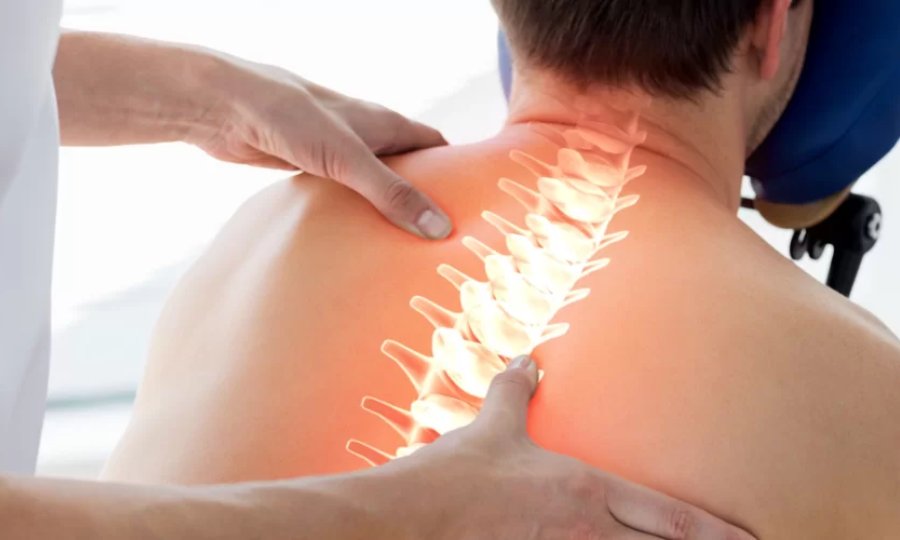In recent years, the number of visits to an orthopedist for thoracic spine problems and pains has increased significantly.
What is the reason?
The significance of the body region is great and lies in maintaining the axis of the spinal column. Nowadays, it can be easily proved that many problems of the cervical region, shoulder girdle, as well as posture disorders, mainly include a change in the curvature of the thoracic region, which manifests earlier than any other symptoms.
Anatomy
The thoracic spine is the largest and least mobile, it consists of 12 vertebrae, each of which, unlike the vertebrae of other regions, has additional joints laterally – costovertebral, which connect the spinal column with the chest. Between the vertebral bodies, as in other regions, there are intervertebral discs that provide flexibility and cushioning throughout the spine. Their peculiarity in this region is that their height is lower, and consequently, the mobility of the region is lower. Physiological rigidity of the thoracic spine is associated, among other aspects, with the formation of the vertebral-rib cage and the location of the spinous processes, which overlap each other in a tiled manner, reducing freedom of movement.

This is what the thoracic spine looks like. The largest parts of the vertebrae – the bodies, form the thoracic kyphosis. The processes located to the right of them are called spinous and overlap each other.
Recently, the function of the upper limbs has increased when working at the computer and in the office, while the movements in the upper back are negligible. The upper back does not get the necessary mobility, so punctate pain can appear in the center of the back or on one of the sides, and there are various reasons for that.
Causes of chest pain

Punctate pain in the center of the back can occur when performing actions and movements in the upper limbs, in the absence of movement in the upper back, for example, when working in front of a computer.
In this case, stiffness may form when a vertebra or several vertebrae move. The stiffness is manifested by a decrease of the degree of the spine movement, in its flexibility formed due to static activity. The upper back does not move for a long time, but stabilizes arm movements. Thus, the load is growing and constantly increasing. As elements of the spinal chain, the vertebrae are connected to each other, but not “glued’. Each can move in relation to the other.
Punctate pain, sometimes radiating to both sides of the chest, can be caused by several vertebrae having reduced their flexibility in relation to each other and not moving properly. The therapeutic approach in such cases requires correcting posture and developing an individual set of exercises that improves muscle synchronization and balance.
From a biomechanical point of view
The thoracic spine plays an important role in redistribution of the load between the upper and lower parts of the body: the diameter and height of the vertebral bodies in this region gradually increase, gradually approaching the size of the lumbar vertebrae. The main elements of maintaining stability in this region are the rib cage, intervertebral discs and ligaments. If any of these elements is impaired, the stability of the thoracic region decreases.
Another important feature of the thoracic spine is the location of the thoracic part of sympathetic nervous system here. The sympathetic system is part of the autonomic nervous system, which is also called “autonomous”. The word “autonomous” here means that it acts without the deliberate human involvement, unconsciously. The autonomic nervous system regulates the work of internal organs: the heart, kidneys, lungs, gastrointestinal tract and other organs, the work of which a human is not able to control consciously.
It is represented by two sympathetic trunks (right and left), which are formed when nerve fibers exit the spinal cord and are located on the sides of the spinal column. We will not go into the details of the difference between the sympathetic and parasympathetic nervous systems, but the following should be noted: due to the location of the trunks of the sympathetic nervous system near the thoracic spine, the occurrence of disorders in this region, including postural disorders, will lead to specific symptoms that are not observed when other regions are damaged. For example, displacement of the vertebrae in the thoracic region can lead to compression of the sympathetic nerves. As a result, the conduction of nerve impulses to the organ that this nerve innervates will be disrupted, the function of the organ will be impaired, and symptoms typical for the disorder will appear. So, for example, if the nerve is connected with the lungs, shortness of breath or coughing may occur, with the diaphragm – hiccups, according to the same principle, pains in the heart, stomach, kidneys, etc. may appear.
Treatment
As preventive measures to prevent the progression of symptoms and pain in the thoracic spine, it is recommended to: properly equip the workplace ergonomically, perform a set of preventive and strengthening physical exercises, select the right types of physical activity and load.
A qualified specialist in physiotherapy and rehabilitation can prescribe you a set of special exercises, physiotherapy procedures, massage, which will allow you to eliminate muscle imbalance and strengthen the musculoskeletal system. The program is formed individually and includes both static and dynamic exercises. Swimming and hydrotherapy are also recommended.
Physiotherapy
Video: “Exercises for the THORACIC SPINE”
SET OF EXERCISES №1 FOR THE THORACIC SPINE. IMPROVING THE DYNAMICS AND MOBILITY OF THE THORACIC SPINE
For additional information about the exercises for the Thoracic spine you can watch a video demonstrating exercises and rehabilitation recommendations.

Check out the demo version of our sets of exercises for Thoracic spine on YouTube
Our website presents the following sets of exercises for the thoracic spine:






